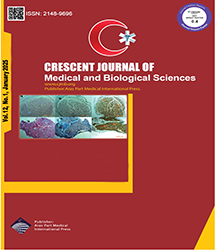
| Original Article | |
| Sexual Quality of Life and Its Contributory Factors in Iranian Couples with Benign Prostatic Hyperplasia-Afflicted Spouses: A Cross-sectional Study | |
| Leila Mohamadkhani Shahri1,2, Farzad Allameh3, Maliheh Nasiri4, Zohreh Keshavarz5 | |
| 1Student Research Committee, School of Nursing and Midwifery, Shahid Beheshti University of Medical Sciences, Tehran, Iran 2Department of Midwifery, Karaj Branch, Islamic Azad University, Karaj, Iran 3Men’s Health and Reproductive Health Research Center, Shahid Beheshti University of Medical Sciences, Tehran, Iran 4Department of Basic Sciences, School of Nursing and Midwifery, Shahid Beheshti University of Medical Sciences, Tehran, Iran 5Department of Midwifery and Reproductive Health, School of Nursing and Midwifery, Shahid Beheshti University of Medical Sciences, Tehran, Iran |
|
|
CJMB 2025; 12: 042-053 DOI: 10.34172/cjmb.2024.3001 Viewed : 3626 times Downloaded : 3656 times. Keywords : Erectile dysfunction, Lower urinary tract symptoms, Prostatic hyperplasia, Quality of life, Spouses |
|
| Full Text(PDF) | Related Articles | |
| Abstract | |
Objectives: The sexual quality of life (SQoL) of the couples can be significantly affected by benign prostatic hyperplasia (BPH). This study aims to investigate the status of SQOL and its contributory factors in 105 Iranian couples with BPH-afflicted spouses, who visited Urology clinics of hospitals affiliated to Shahid Beheshti University of Medical Sciences in Tehran-Iran. Materials and Methods: In this descriptive cross-sectional study, , the data were collected using questionnaires of Sexual Quality of Life-Male (SQoL-M), Sexual Quality of Life-Female (SQoL-F), International Prostate Symptoms Score (IPSS), International Index of Erectile Function (IIEF), and Female Sexual Functional Index (FSFI). Multiple regression was performed using SPSS 20 software. Results: The variables of IIEF Overall Satisfaction sub-score (IIEF-OS) (B=2.895, P<0.001), IIEF Erectile Function sub-score (IIEF-EF) (B=0.481, P<0.001), FSFI Pain sub-score (FSFI-P) (B=-2.348, P=0.001), male"s Financial situation (B=4.417 P=0.034), and disorder in male"s social life (B=5.553, P=0.013) were the final predictors of Men"s SQoL (R2=0.677, ADJ.R2=0.660, R=0.823). The variables of FSFI Satisfaction sub-score (FSFI-S) (B=9.223, P<0.001), FSFI-P (B=-1.696, P=0.028), and IIEF-OS (B=2.918, P=0.002) were the final predictors of their women"s SQoL (R2=0.724, ADJ.R2=0.716, R=0.851). Conclusions: In sum, the negative effect of BPH on the SQoL of the couples was confirmed and variables such as the male"s financial situation from the socio-demographic factors, disorder in the male"s social life from the factors related to BPH and FSFI-P, IIEF-OS Along with IIEF-EF from the factors of related to the couple"s sexual function (FSFI and IIEF) were identified as the final predictors of Men"s SQoL. Also, the variables of FSFI-S, FSFI-P, and IIEF-OS from the factors of related to the couple"s sexual function (FSFI and IIEF) emerged as the final predictors of Women"s SQoL. Accordingly, the sexual function of the couples with BPH was identified as one of the final predictors of their SQoL. Therefore, proper counselling and increased sexual awareness among couples may have played an important role in improving the quality of their sexual lives. It was recommended that health policy makers should prioritize the significance of SQoL and its association with the overall health of the couples with BPH in educational programs. |
Cite By, Google Scholar
Google Scholar
PubMed
Online Submission System
 CJMB ENDNOTE ® Style
CJMB ENDNOTE ® Style
 Tutorials
Tutorials
 Publication Charge
Medical and Biological Research Center
About Journal
Publication Charge
Medical and Biological Research Center
About Journal
Aras Part Medical International Press Editor-in-Chief
Arash Khaki
Deputy Editor
Zafer Akan


















